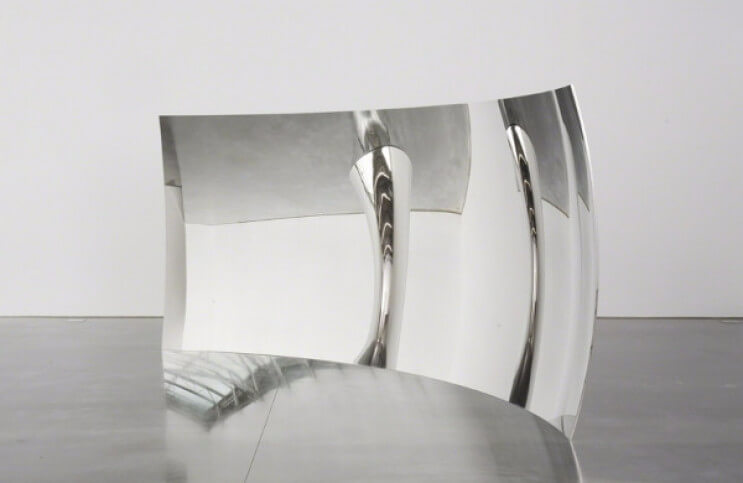
Anish Kapoor and the Abstract Essence in Space
When is form not form, and color not color? How do we create space by filling space? Can we separate the abstract essence of a phenomenon from its material presence? These are some of the mysteries we are invited to explore through the artwork of Anish Kapoor. This Indian-born British abstract artist has become renowned in recent decades for the various large-scale public artworks he has created around the world. Tens of millions of viewers encounter his works each year. He is as famous for the objects themselves as for the conceptual issues they raise. To Kapoor, the conceptual side of the work is the whole point. He is not making things for the purpose of making things. He is following an experimental path into the unknown, following his instincts and his inspiration, guiding his team through the process of the physical realization of the abstract essence of his ideas. Anish Kapoor is searching for meaning, not by offering answers but by striving to discover the right questions.
Descension – Into Mystery
When Anish Kapoor begins a new sculpture, he does not start with a blueprint, or even a sketch of what the finished form will be. He is not interested in the form. “Artists don't make objects,” he has said. “Artists make mythologies.” Kapoor is interested in process. He may start with a new material and just begin working with it, exploring what it wants to become. Or he may begin with a simple, universal concept, like that of the unknown, and see where it guides his imagination. He has described his artistic process as similar to a fool going on a journey, not knowing where it will lead, but becoming enlightened along the way.
In fact, Descension, one of his most memorable recent artworks, demonstrates those very notions of mystery, process, and the lure of the unknown. First installed in India as part of the 108-day contemporary art fair, the Kochi-Muziris Biennale, Descension took the form of an endless, spiraling whirlpool of black water in the floor, surrounded by a metal railing. The work next traveled to Italy, where it again appeared in a floor where viewers could walk right up to the edge and stare down into the dark, swirling vortex. Then in October of this year, the work appeared in massive scale in the river Seine in Paris, as part of Nuit Blanche 2016. As with many works by Kapoor, Descension is only a beginning point. He built a spinning mechanism. The aesthetic result depends on the water and other natural forces. Says Kapoor, it is, “a transitional space, an in-between space…a space of becoming.”
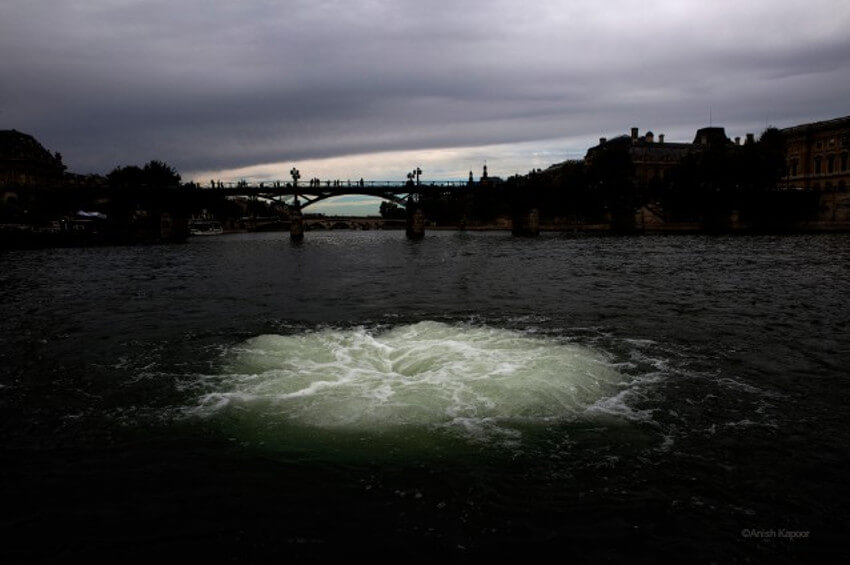 Anish Kapoor - Descension, Nuit Blanche 2016, Paris. © Anish Kapoor
Anish Kapoor - Descension, Nuit Blanche 2016, Paris. © Anish Kapoor
Cloud Gate – Creating Space
At the turn of the 21st Century, the city of Chicago offered Anish Kapoor the opportunity to create his first public sculpture in the United States. Kapoor won out over 29 other artists, including Jeff Koons, who were invited to submit proposals for a public sculpture to be included in Millennium Park, the massive redesign of a 99,000-square meter section of downtown public shoreline. The design Kapoor submitted, a biomorphic, reflective object visitors can walk underneath, is formally titled Cloud Gate. The people of Chicago immediately nicknamed it The Bean, which, according to the Chicago Sun Times, Kapoor called completely stupid.
The abstract essence of Cloud Gate can be found in its reflective surface, which is completely free from any visible seams or interruptions of any kind. It reflects unbroken images of the sky and the lake and the architecture of the city, as well as the millions of viewers that visit it each year. Though it occupies space, it is also the embodiment of created space, as it increases the ability of viewers to perceive more of their surroundings. It has the effect of minimizing the scale of the towering skyscrapers while enlarging the scale of viewers as they approach it. The increase in apparent space combined with the revaluing of scale causes the sky to seem closer to the ground. The space created is therefore not only physical but also intellectual, allowing for new internal perceptions to come into existence along with the external illusions.
 Anish Kapoor - Cloud Gate, Millennium Park, Chicago, IL, 2004. © Anish Kapoor
Anish Kapoor - Cloud Gate, Millennium Park, Chicago, IL, 2004. © Anish Kapoor
Dirty Corner – The Void
As part of a temporary exhibition called Kapoor Versailles, six Anish Kapoor sculptures were installed around the grounds of the Palace of Versailles in France in 2015. Among them was a 60 x 8 meter, steel, funnel-shaped sculpture called Dirty Corner. The most prominent feature of the sculpture is a large opening leading inward toward an unknown dark void. When it was being installed in Versailles Kapoor referred to Dirty Corner as a she, and referenced feminine power. The French Press immediately nicknamed the work “The Queen’s Vagina.” Shortly after being installed, the sculpture was vandalized with splashed yellow paint. Kapoor cleaned it, but then it was immediately vandalized again, this time with anti-Semitic graffiti.
The Palace of Versailles housed Queen Marie Antoinette at the dawn of the French Revolution. In its centuries of existence it has been the source of extensive controversy, especially as vast wealth and effort have been expended to maintain and restore it. It is hard to imagine a single work of art could have made the location more controversial. But Dirty Corner has done just that. After the second vandal attack, Kapoor left the graffiti there, despite the outrage that decision caused. He suggested to the press that perhaps the sculpture was asking for it, stating, “Art is a process of experimentation where certain things arrive and you try to follow them. In the end, one has to trust the work does its own thing.” When later forced to erase the graffiti by the courts, Kapoor explains on his website, “I refused this ridiculous ruling, choosing instead to cover the vile slogans in gold leaf as a partial mask. The hate would remain covered with a thin veneer of gold.”
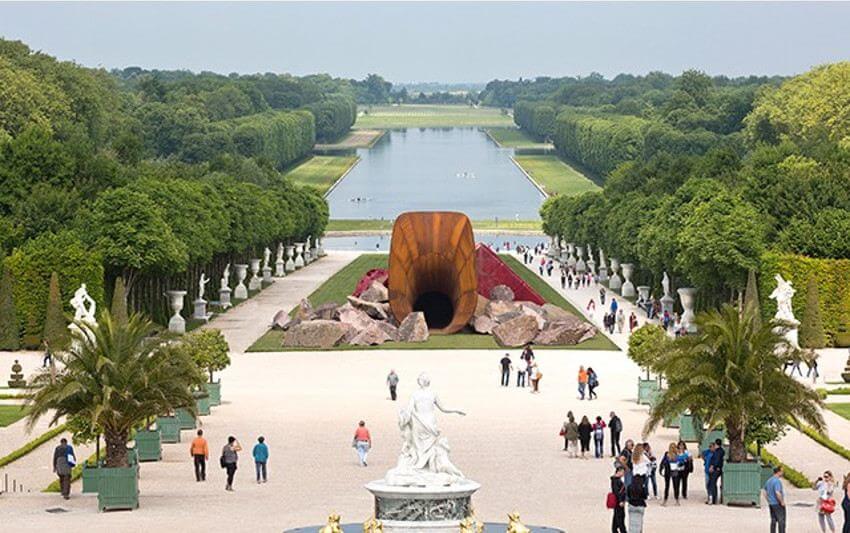 Anish Kapoor - Dirty Corner, Château de Versailles, 2015. © Anish Kapoor
Anish Kapoor - Dirty Corner, Château de Versailles, 2015. © Anish Kapoor
Vantablack – Devouring Time and Space
What we can expect in the future from Anish Kapoor will in some degree be informed by his recent acquisition of the exclusive rights to use a fascinating new material called Vantablack, which is the darkest substance ever created. Although from a distance it looks like a synthetic medium like paint or fabric, Vantablack cannot be applied or spread onto a surface. It must be grown. Developed by an Austrian company called Surrey NanoSystems for use in satellite technology, Vantablack consists of dense, microscopic forests of carbon nanotubes. When light radiation enters the nanotube forest, it becomes trapped and cannot escape. The substance absorbs 99.965% of the visible spectrum of light, making it the darkest man-made substance ever created.
One of the reasons Anish Kapoor was given exclusive rights to use Vantablack in creative works of art is because he maintains such a rigorously experimental operation. He has the scientific and technical infrastructure in place to be able to work with such a highly technical material. And Kapoor has been blessed with tremendous financial success. Ounce per ounce, Vantablack is far more expensive than gold or diamonds, and may be the most expensive substance on the planet at the moment. What will Kapoor use this substance for? He has spoken about the possibility of creating an aesthetic experience in which a viewer could be completely immersed in this total darkness, freeing the mind from all perception of time, space and scale. This could be the ultimate manifestation of many of the themes Kapoor investigates, from the idea of the void, to the notion of mystery and the unknown, and especially the concept of filling space with an object that somehow creates space.
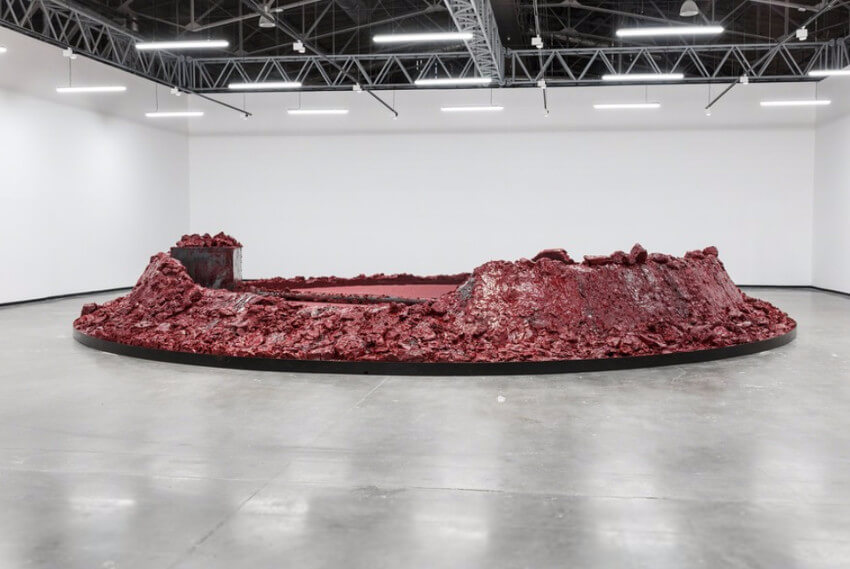 Anish Kapoor - My Red Homeland, 2006, photo by Nic Tenwiggenhorn
Anish Kapoor - My Red Homeland, 2006, photo by Nic Tenwiggenhorn
About Form
Based on everything Anish Kapoor has said about his art, there can be no doubt that to Kapoor his work is not about form. He does not set out to create a certain form, and he does not intend for the form of his artworks to get in the way of their other potentialities. His process is about earnest experimentation, a journey of exploration through which he hopes to arrive at revelation along the way. But it is also telling that Kapoor has often reacted emotionally when his public sculptures have acquired nicknames, such as The Bean and The Queen’s Vagina. Perhaps that is because those nicknames seem to be exclusively related to form.
But herein lies an insight that may be valuable to our ability to take the full measure of these artworks. Kapoor gives his creations whatever name he predicts will best allow them to serve their intended purpose in the world. But the viewers fulfill that purpose as they complete the work through their experience of it. People give nicknames to things that are memorable. They invent nicknames that make sense according to their experience with the world. Whatever nickname viewers give to a work, it has its root not in form, but in truth. Perhaps that truth includes form, or perhaps it speaks to something larger, something abstract. Beans and sexual organs both, after all, represent the beginning of much larger things.
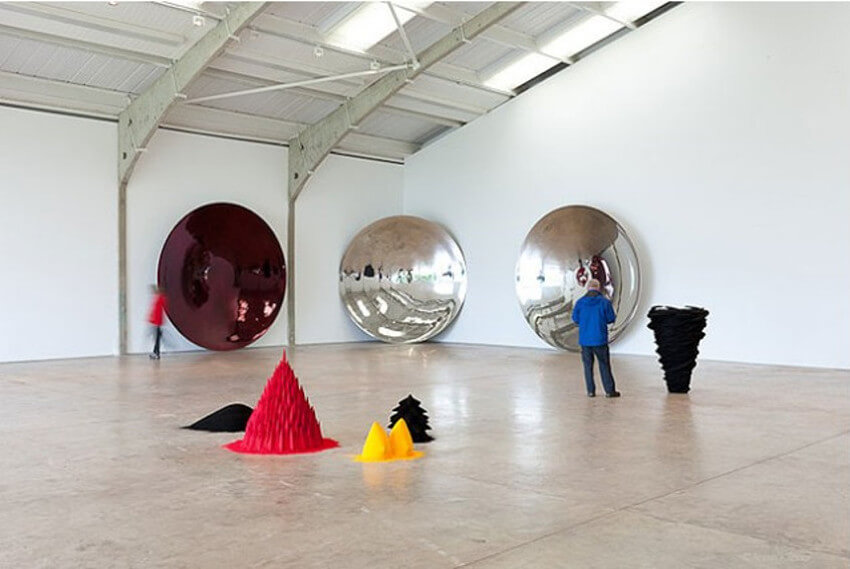 Anish Kapoor - Yorkshire Sculpture Park, 2012, Longside Gallery. Courtesy Longside Gallery
Anish Kapoor - Yorkshire Sculpture Park, 2012, Longside Gallery. Courtesy Longside Gallery
Featured image: Anish Kapoor - Vertigo, 2006, photography by Dave Morgan
All images used for illustrative purposes only
By Phillip Barcio






